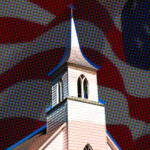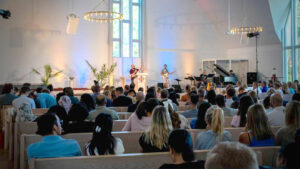On Friday Republican presidential candidate Ben Carson officially ended his campaign and revealed he will be the national chairman of My Faith Votes, a non-partisan group that “exists to inspire and motivate Jesus followers to vote.” Because of the focus on his personal faith, Carson became the most prominent American member of the Seventh-day Adventist Church.
Here are nine things you should know about that denomination:

1. Seventh-day Adventists compose one-half of 1 percent of the U.S. adult population, and 1.2 million people in the North America belong to the denomination. But around the world there are 18.1 million SDAs, making them a larger global presence than the Southern Baptist Convention (15.5 million), the United Methodist Church (12.8 million), or Mormonism (15.3 million).
2. Seventh-day Adventism (hereafter SDA) sprung up in upstate New York in the 1840s, an offshoot of the Millerite movement that arose during the religious revival known as the Second Great Awakening. At that time a Baptist preacher named William Miller predicted and preached that, based on his reading of Daniel 8:14, Christ would return sometime between March 21, 1843, and March 21, 1844. The failure of this prediction—known as the Great Disappointment—led many Millerites to become disillusioned. But Hiram Edson claimed to have seen a vision of Jesus standing at the altar of heaven and concluded that Miller had been right about the time but wrong about the place. As Matt Slick explains, “In other words, Jesus’s return was not to earth but a move into the heavenly sanctuary as is referenced in Hebrews 8:1-2.” The development of this doctrine, known as “Sanctuary/investigative judgment” (see below), influenced Joseph Bates and James and Ellen White, the founding pioneers of the SDA church.
3. SDAs claim the Bible as their “only creed” and consider the movement to be “the result of the Protestant conviction Sola Scriptura—the Bible as the only standard of faith and practice for Christians.” They hold “certain fundamental beliefs to be the teaching of Holy Scriptures,” doctrines known as the 28 Fundamental Beliefs, which are organized into six categories—the doctrines of God, man, salvation, the church, the Christian life, and last day events.
4. The 28 Fundamental Beliefs are considered descriptive of the church’s official position, but they are not prescriptive for membership. Baptism by immersion is the criteria for membership, which is predicated on a public examination of candidates either before the entire congregation, a church board, or elders. The minister or elder can give the candidate one of two sets of baptismal vows, one consisting of 13 vows or one consisting of the following three questions:
1. Do you accept Jesus Christ as your personal Savior and Lord, and do you desire to live your life in a saving relationship with him?
2. Do you accept the teachings of the Bible as expressed in the Statement of Fundamental Beliefs of the Seventh-day Adventist Church, and do you pledge by God’s grace to live your life in harmony with these teachings?
3. Do you desire to be baptized as a public expression of your belief in Jesus Christ, to be accepted into the fellowship of the Seventh-day Adventist Church, and to support the church and its mission as a faithful steward by your personal influence, tithes and offerings, and a life of service?
5. Most of the 28 Fundamental Beliefs are similar to doctrines professed by evangelical Protestant denominations. The three main SDA doctrines considered heterodox by evangelicals are Sabbatarianism (a required observance of the Sabbath, which they believe falls on Saturday), the gift of prophecy as “manifested in the ministry of Ellen G. White,” and the Sanctuary Doctrine.
6. The Sanctuary Doctrine is the most distinctive Adventist doctrine. Orthodox Christians commonly hold that Jesus, as our high priest, intercedes for us at God’s right hand (Heb 4:14-16; 6:20; 7:25). But SDAs also believe that Christ entered the “sanctuary in heaven” and after a “prophetic period of 2,300 days” (ending in 1844) he entered the second and last phase of his atoning ministry, a work of “blotting out” sin. As Kenneth R. Samples explains,
From his ascension until 1844, Jesus had been applying the forgiveness he purchased on the cross in the first compartment of the sanctuary, but in 1844, he entered the second compartment and began to investigate the lives of those who had received forgiveness to see if they were worthy of eternal life. Only those who passed this judgment could be assured of being translated at his coming. This doctrine gave rise to what later became known as the sinless perfection teaching (perfect commandment-keeping in order to find acceptance in the judgment). Following the investigative judgment, Christ would come out of the heavenly sanctuary and return to earth bringing to every man his reward, and ushering in the great and terrible day of the Lord. It is 1844, and the events described above, which mark the beginning of SDA.
7. The other unique belief of SDA is in the “prophetic” ministry of Ellen G. White (1827-1915). During her lifetime White produced more than 5,000 periodical articles and 40 books totaling some 25 million words. (SDAs claim, probably correctly, that White is the “most translated woman in literature.”) From the time she was 17 years old until she died 70 years later, she claimed to have had approximately 2,000 visions and dreams, ranging from less that a minute to four hours. The 27 Fundamental Beliefs states, “Her writings speak with prophetic authority and provide comfort, guidance, instruction, and correction to the church. They also make clear that the Bible is the standard by which all teaching and experience must be tested.” Some Adventist scholars claim that as much as 90 percent of White’s writings were plagiarized, though the White estate claims it is only about 2 percent.
8. For about a hundred years—1840s to 1950s—many evangelical denominations considered SDA to be a non-Christian cult (like the Jehovah’s Witnesses). But dialogue with SDA scholars and apologists in the 1950s led to a reconsideration of that position by some evangelicals. As Kenneth R. Samples says, the dialogue convinced many that “SDA was not an anti-Christian cult, but rather a somewhat heterodox (i.e., departing from accepted doctrine) Christian denomination.” The Christian Research Institute provides a key example of the rationale for this view:
Since SDA does accept the foundational doctrines of historic Christianity (the Trinity, Christ’s true deity, his bodily resurrection, etc.) we do not believe that it should be classified as a non-Christian cult. It is our conviction that one cannot be a true Jehovah’s Witness, Mormon, Christian Scientist, etc., and be a practicing Christian in the biblical sense of the word; but it is possible to be a Seventh-day Adventist and a true follower of Jesus, despite certain distinctive Adventist doctrines which we consider to be unbiblical.
Although few evangelicals today consider SDA a non-Christian cult, many still caution against embracing the denomination as an acceptable branch of Protestantism. As Nathan Busenitz says, “In spite of the ecumenical spirit that has pervaded evangelicalism over the last few decades, there are still major deficiencies within official SDA theology that ought to give evangelical Christians serious pause.”
9. The question and answer sessions between evangelical and SDA scholars in the 1950s led to the release of the Adventist publication Questions on Doctrine, a document considered to be the origin of “Evangelical Adventism.” However, not everyone in the SDA church agreed with this book or its positions. Some considered it a watering down of “traditional” Adventists teachings to appease evangelicals. Those who endorse this view are sometimes referred to as subscribing to “Traditional Adventism.” Kenneth R. Samples identifies five positions commonly held by Traditional Adventists:
1. Righteousness by faith: Righteousness by faith included both justification and sanctification. Our standing before God rests both in the imputed and imparted righteousness of Christ (God's work for me and in me). Justification is for sins committed in the past only.
2. The human nature of Christ: Jesus Christ possessed a human nature that not only was weakened by sin, but had propensities toward sin itself. His nature was like that of Adam after the fall. Because of his success in overcoming sin, Jesus is primarily our example.
3. The events of 1844: Jesus entered into the second compartment of the heavenly sanctuary for the first time on October 22, 1844, and began an investigative judgment. This judgment is the fulfillment of the second phase of Christ’s atoning work.
4. Assurance of salvation: Our standing before God rests in both the imputed and imparted righteousness of Christ; assurance of salvation before the judgment is presumptuous. As Jesus, our example, showed us, perfect commandment keeping is possible.
5. The authority of Ellen G. White: The spirit of prophecy was manifest in the ministry of Ellen White as a sign of the remnant church. Her writings are inspired counsel from the Lord and authoritative in doctrinal matters.
Other articles in this series:
Justice Antonin Scalia (1936–2016) • Female Genital Mutilation • Orphans • Pastors • Global Persecution of Christians (2015 Edition) • Global Hunger • National Hispanic Heritage Month • Pope Francis • Refugees in America • Margaret Sanger • Confederate Flag Controversy • Elisabeth Elliot • Animal Fighting • Mental Health • Prayer in the Bible • Same-sex Marriage • Genocide • Church Architecture • Auschwitz and Nazi Extermination Camps • Boko Haram • Adoption • Military Chaplains • Atheism • Intimate Partner Violence • Rabbinic Judaism • Hamas • Male Body Image Issues • Mormonism • Islam • Independence Day and the Declaration of Independence • Anglicanism • Transgenderism • Southern Baptist Convention • Surrogacy • John Calvin • The Rwandan Genocide • The Chronicles of Narnia • The Story of Noah • Fred Phelps and Westboro Baptist Church • Pimps and Sex Traffickers • Marriage in America • Black History Month • The Holocaust • Roe v. Wade • Poverty in America • Christmas • The Hobbit • Council of Trent • C.S. Lewis • Halloween and Reformation Day • Casinos and Gambling • Prison Rape • 6th Street Baptist Church Bombing • 9/11 Attack Aftermath • Chemical Weapons • March on Washington • Duck Dynasty • Child Brides • Human Trafficking • Scopes Monkey Trial • Social Media • Supreme Court's Same-Sex Marriage Cases • The Bible • Human Cloning • Pornography and the Brain • Planned Parenthood • Boston Marathon Bombing • Female Body Image Issues • Islamic State
Download your free Christmas playlist by TGC editor Brett McCracken!
 It’s that time of year, when the world falls in love—with Christmas music! If you’re ready to immerse yourself in the sounds of the season, we’ve got a brand-new playlist for you. The Gospel Coalition’s free 2025 Christmas playlist is full of joyful, festive, and nostalgic songs to help you celebrate the sweetness of this sacred season.
It’s that time of year, when the world falls in love—with Christmas music! If you’re ready to immerse yourself in the sounds of the season, we’ve got a brand-new playlist for you. The Gospel Coalition’s free 2025 Christmas playlist is full of joyful, festive, and nostalgic songs to help you celebrate the sweetness of this sacred season.
The 75 songs on this playlist are all recordings from at least 20 years ago—most of them from further back in the 1950s and 1960s. Each song has been thoughtfully selected by TGC Arts & Culture Editor Brett McCracken to cultivate a fun but meaningful mix of vintage Christmas vibes.
To start listening to this free resource, simply click below to receive your link to the private playlist on Spotify or Apple Music.


































